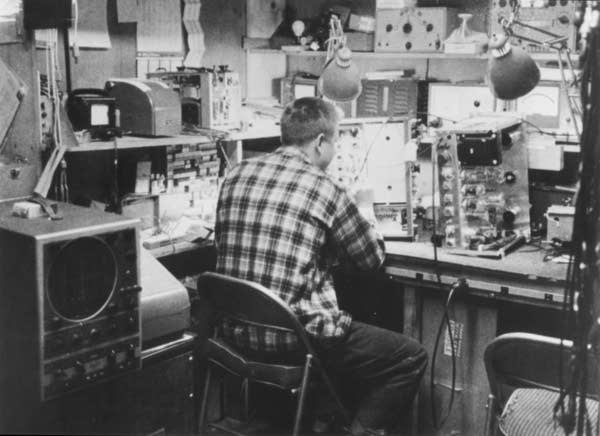Halloween blackout of '57 spurs creation of portable pacemaker
Go Deeper.
Create an account or log in to save stories.
Like this?
Thanks for liking this story! We have added it to a list of your favorite stories.

At the University of Minnesota hospital 50 years ago, surgeons had recently started using pacemakers to help children recover from heart surgery. The devices plugged into a wall socket, so when the power went out in patients' rooms, their pacemakers stopped working too.
It's hard to piece together exactly what it was like at the hospital during the blackout. But what can be gleaned from old newspaper accounts paints a frenzied picture, according to historian Jack Norton.
"They had police officers pull up to the side of the surgery suites and simply turn on their headlights to provide light for the surgeons," says Norton. "They scrambled to try and keep blood cold by grabbing ice from various coolers to stick in the blood refrigerator."

Norton dug up dozens of newspaper stories about the blackout while doing research for Medtronic. He says the articles show that the university hospital had no reason to suspect it was vulnerable to a power failure because it was connected to two different power plants.
Turn Up Your Support
MPR News helps you turn down the noise and build shared understanding. Turn up your support for this public resource and keep trusted journalism accessible to all.
"They thought if one of them went down, the other would provide them with electricity," says Norton.
But this was a rolling blackout that took down plants all across the power grid. No one anticipated that happening, Norton says.
"It's a nightmare scenario and there's a certain amount of irony that it happens on Halloween, that this nightmare in critical care happens on the day when we all know it's famed for scary happenings."
Probably the scariest place to be that morning was the children's cardiac recovery unit. A number of young kids were connected to pacemakers after undergoing heart surgery.
"We got together and talked about it and said we have to have some way to back these pacemakers up when there's a power failure."
When the power went off, doctors scrambled to find drugs to keep their patients hearts pumping. Still, one child didn't survive the three hour ordeal.
The trauma of that event rattled pioneering University of Minnesota heart surgeon C. Walter Lillehei. The next day in the hospital hallway Lillehei flagged down Earl Bakken, an electrical engineer who spent a lot of his time collaborating with university surgeons on new medical devices.
Bakken had just started Medtronic a few years earlier and was still running the company out of his garage. Bakken says Lillehei was clearly troubled about the blackout.
"We got together and talked about it and said we have to have some way to back these pacemakers up when there's a power failure," Bakken said in a recent interview.
Lillehei asked Bakken if he could create a portable pacemaker that ran on a battery.

"So we talked about well how do we do that? How do we get the battery backup?," says Bakken. "And I said, 'Well, we'll take a six volt automobile battery and then use an inverter to convert the six volts to 115 volts to run the pacemaker.'"
Bakken and a his employees built the device. Bakken says it would have worked fine, but the car battery produced more power than he needed for his pacemaker. So he started looking for alternatives.
Then he remembered an article he had read in his Popular Electronics magazine. It was about a new circuit for a metronome.
"A metronome has the same rates as heart rates," says Bakken.
The metronome circuit also had the advantage of being much smaller. Bakken's invention fit in a box about the size of a small paperback book, which meant the pacemaker could be placed in the bed with the patient, rather than on a medical cart next to the bed. Bakken took his new invention to the University of Minnesota and tested it out on a laboratory dog that had been given an artificial heart block.
"And I said, 'Okay now. This seems to work, so I'll go back to my garage and make a pacemaker we can use on humans,'" says Bakken.

But he never got the chance. When Bakken returned to the hospital the next day, he saw his invention being used in the recovery room.
"There was a child in there with this pacemaker connected to him...What a great feeling that is to see here's something we made with our own hands keeping this child alive."
Still Bakken wasn't convinced his portable pacemaker was really ready for human use. He sought out Lillehei and asked him why he didn't wait for the human version of the machine.
"And he said well as long as this battery operated pacemaker was available he wasn't going to risk losing another child to a power failure."
Bakken says it was probably inevitable that a portable pacemaker would have been invented in the 1950's even if he hadn't created the device. Surgeons at the time were making remarkable advances in treating heart conditions. He says the Halloween blackout simply highlighted the urgency in developing new medical technologies as fast as possible.
It's a trend that continues today.
Modern pacemakers have advanced considerably in the past 50 years. They're still battery operated. But they're much smaller. They fit in the palm of your hand. And they're no longer a piece of excess body baggage. They are implanted directly into a patient's chest, making it much easier for patients to lead normal lives.



